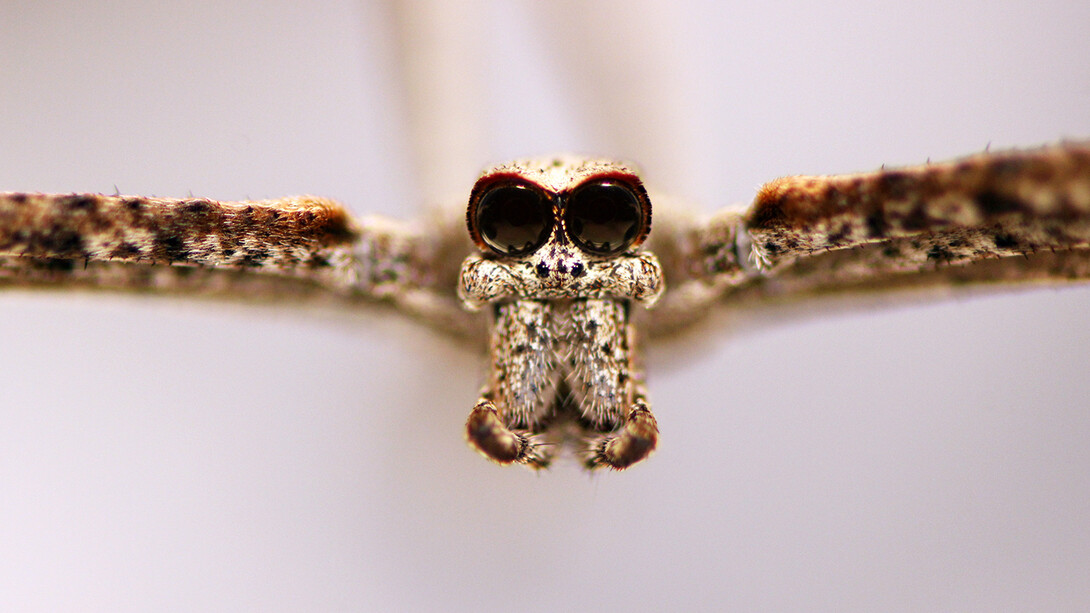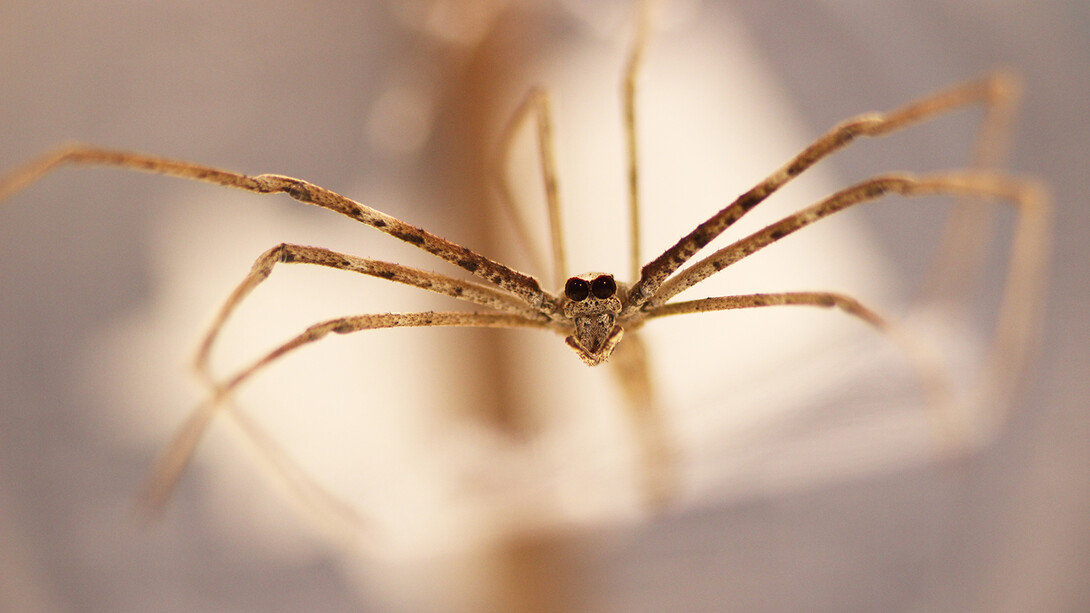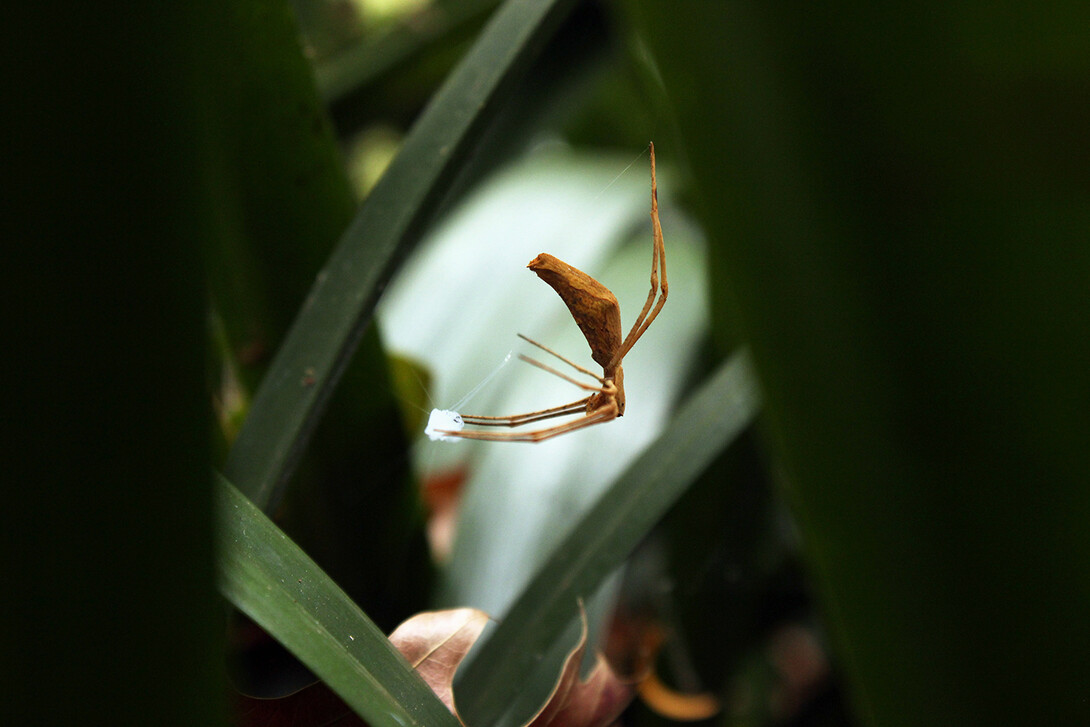
Ogre-faced spiders may boast the largest eyes among arachnids, but hearing — even minus the “ear” — is their spidey-sense of choice for netting moths, mosquitoes and other fly-by-night prey, says a new study from Cornell University and the University of Nebraska–Lincoln.
Published Oct. 29 in the journal Current Biology, the study details both neural and behavioral evidence that the species Deinopis spinosa can employ leg-housed sensory organs to detect the sounds of aerial prey from more than 6 feet away.
D. spinosa hunts by rappelling down from an A-shaped web, then dangling like a motionless trapeze artist as it holds a net of wooly silk between four twig-like forelegs. If prey approaches from the ground, the nocturnal predator lunges downward, casting its net over the unhappy meal in just a thousandth of a second. When a flying insect enters its airspace, the spider instead ballistically flings itself backward and upward — akin to a bungee-jumper recoiling from the nadir of a fall — while splaying its forelegs wide to maximize the net’s surface area and blanket the incoming insect.
As a doctoral student researching in the lab of Nebraska’s Eileen Hebets, Jay Stafstrom previously found that D. spinosa struggled to land ground-bound prey when its gigantic secondary eyes were obstructed. But he also discovered that the species captured airborne insects just as well without the aid of those signature light-drinking eyes.
“After that first study, we were pretty sure that the big eyes are used more specifically for catching things on the ground, and they’re probably not using vision to catch things out of the air,” said Stafstrom, now a postdoctoral researcher under Ronald Hoy at Cornell.
When it came to aerial prey, Stafstrom and his mentors figured another of the senses must be in play. The prime candidate: hearing. The prime complication: “They don’t have ears,” Stafstrom said, “which is a weird part of this.”

Still, Stafstrom, Hebets and Hoy knew that elementary evidence for auditory perception in spiders, specifically the cob-web and a few other varieties, stretched back to the 1950s. More recently, Hoy’s lab has uncovered evidence of long-range hearing in jumping spiders.
“And there are some other pieces of evidence that they might be hearing,” Stafstrom said of the ogre-faced spiders. “People have shown that if you cough at them, they will strike at you.”
Alas, Stafstrom would need more than a cough to make the scientific case, so he decided to run a few experiments. To test the acoustic, he and the team first had to go electric. After anesthetizing and restraining D. spinosa specimens in the lab, Cornell’s Gil Menda implanted microscopic electrodes in their brains, playing noise as he very slowly, very carefully plunged the electrode’s tungsten tips into the tissue. When the electrodes began picking up electrical activity in response to the noise, Menda knew he had reached the auditory region of the brain.
The team then played a range of frequencies through a speaker stationed about 6 feet away, monitoring the neural responses of the spiders. As expected, electrical activity in their brains spiked when the speaker played certain frequencies between 100 and 1,000 hertz — the low frequencies generated by the wingbeats of midges, moths and other common flying prey.

The data essentially proved that D. spinosa was perceiving and interpreting the frequencies. But a more fundamental question remained: Without ears, how exactly was the spider sensing them?
Prior research led the team to suspect that slit sensilla — strain-detecting organs present in all known spiders, and residing just above the lowest leg joints in D. spinosa — would be sensitive to the sound waves. Sure enough, electrodes embedded near the organs detected electrical spikes in response to the same low-frequency tones that triggered the brain activity. And when the team hyperextended the lowest leg segment with a Q-tip to dampen the organ’s vibrations, similar to the way a hand might a crash cymbal, the corresponding electrical activity plummeted.
Painstaking as it was, incorporating electrodes and measuring neural activity can be the sort of methodology needed to uncover the oft-hidden sophistication of arachnid adaptations, Hebets said.
“Our understanding of arachnids, in general, is really poor compared to other animal groups,” said Hebets, Charles Bessey Professor of biological sciences at Nebraska. “One of the things that has constrained some of the work has been technology and techniques and approaches. When it comes to neurobiology and electrophysiology, arachnids pose certain challenges that other arthropods don’t. We know a whole lot about a lot of different insect groups in terms of their sensory capacities, but with arachnids, it’s like a drop in the bucket (by comparison).”
‘They’re like little Transformers’
Stafstrom had his evidence that D. spinosa was attuned to the droning of its prey. What he lacked, and what he wanted, was ecological confirmation that the spider was acting on those auditory cues — that sound was actually driving its aerial attacks. So he made a return expedition to north-central Florida, near the site of his earlier field experiments on D. spinosa’s famous, humongous eyes.
There, just as he had before, Stafstrom mostly adopted the nocturnal schedule of his eight-legged subjects, sleeping in a tent during the day so that he could emerge at night to gather data. His plan was simple: Find D. spinosa specimens, play audio recordings of the relevant frequencies from a few feet away, then video-record whether the spiders unleashed the backward strikes they typically use to snare airborne insects.

Though the darkness presented obvious issues, Stafstrom had long since grown used to operating in it. Same for the heat, humidity and precipitation of the Florida field site, just south of Gainesville. What was almost intolerable, he said, was a familiar buzzing that D. spinosa might treat as a dinner bell but told Stafstrom he was about to become a feast.
“I’m there with a camera in one hand and a speaker in the other, trying not to squirm too much from the mosquitoes drinking my blood,” Stafstrom said. “Whenever I’m collecting spiders, I’m always on the move. If I stop to squat and look around, there’s a timer in my head: ‘You’ve got 3, 2, 1. Haven’t found anything? Get up and walk away.’
“But with this setup, I had to stand there and hold things steady while I knew that there were mosquitoes (around). Consciously, I’ll take the trade-off. I’ll let 20 mosquitoes bite me, but I just don’t want to hear them. Just bite me, and I’ll be OK with it. But having to stand steady while these things are buzzing around you, it’s a bit maddening. I have so much footage of me screaming like a little kid, swearing, trying to film it and then just being like, ‘I can’t do it! I can’t do it!’ and just walking away.”

Even so, Stafstrom said the outcome was worth the effort. Of the 25 D. spinosa specimens he tested in the field, 13 responded to at least one of the relevant frequencies with a backward strike. When Stafstrom later recreated the experiment in a laboratory setting at Cornell, he got even more promising results, with 32 of 51 specimens unleashing a backward strike immediately after exposure to a low-frequency tone. Never, in the field or the lab, did the spiders respond similarly to a white noise recording that served as the control condition.
Nor did the spiders ever respond, at least behaviorally, to higher-frequency tones in the 1,000 to 10,000 hertz range. Given that no flying insect on the D. spinosa menu buzzes at those frequencies, there was no reason to expect otherwise. The team was caught off guard, then, upon seeing that electrical activity in both the D. spinosa brain and slit sensilla did jump when exposed to some frequencies within that higher range.
“The weirdest thing is that they do hear these high frequencies, and we’re not 100% certain why,” Stafstrom said.
He may not have an answer just yet, but Stafstrom does have a hypothesis borne of the hundreds of hours he’s spent tracking and observing the species. As fearsome and active as they are at night, the spiders seem just as vulnerable and still in the daylight, he said, camouflaging themselves to near-invisibility by lying prone on palm fronds.
“They look like little sticks or twigs,” Stafstrom said. “They’re like little Transformers. It’s ridiculous. That, to me, and probably to most other researchers, says that they’ve been picked off and eaten by some visual predator for many generations.”
If ecology and his own expeditions to Florida are any guide, those predators might be songbirds whose chirps or whistles reach a much higher register.
“I couldn’t tell you exactly how it’s going to benefit this thing that already looks 100% like a twig, but it might wake them up,” he said. “While they’re sitting there hoping that they don’t get eaten every day, they’ve probably turned off their attention, because they’re not doing anything but sitting there like a stick. Being able to detect potential predators coming from distance might help them (realize), ‘I need to get my get my act together, because this might be life-or-death really soon.’”

Stafstrom, who has researched D. spinosa with funding from the National Science Foundation, already has a few ideas about how to test that hypothesis. Hebets said her former doctoral advisee’s openness to looking beyond sight is especially vital with arachnids, which trace an evolutionary lineage dating back more than 300 million years. As ancient as they are, she said, their sensory systems may have the potential to inspire innovation in the same way that some of their better-studied novelties — their silk, their hydraulics — already have.
“Scientists have focused on communication channels and sensory modalities that are the easiest to look at and that are the most familiar to us,” Hebets said. “Because we are very visually oriented animals, there are a lot of sensory modalities that we just don’t pay attention to. As soon as we start looking, almost every time, we find examples of these arachnids using crazy sensory systems that we’ve never even thought to look for before.
“These are sensory systems that could have directly translatable applications to humans, whether it be for listening devices or earthquake detection. There’s a whole series of ways in which you can imagine (that) understanding more about the sensory organs in arachnids could be translated into useful human technology. I feel like we’re just at the tip of the iceberg here, and some of these techniques … have just opened up whole new avenues of research. So I think it’s a really exciting time.”







